|
Death Adder Caging. The set-up used by Raymond Hoser as of 2002-2003.
|
Persons who have not kept Death Adders before are advised to use the set-up illustrated as a template for success with these snakes.
BELOW are photos of the standard cage housing for Death Adders (of all species) at the Hoser facility as of 2003. The first cage photo (immediately below) is for the adults and also shown in later photos on this webpage are two size classes for smaller snakes. There are only three size classes of cage required, namely the large size, an intermediate 30 cm long size and the 15 cm long "Chinese Food Tubs" for neonates. In the photo immediately below, the cage to the left with the fly wire lid is used for a Diamond Python to allow in natural sunlight. Such a lid isn't needed for Death Adders, hence the uncut lid to the right. Also note the ventilation holes on the sides of the cage. These are sufficient. The dimensions of the cage are approximately 59 cm long X 35 cm wide X 23 cm high. Each is of plastic construction with a hardened clay base for a substrate, over which is placed a small number of leaves. At the opposite end to the water bowl the cage sits over a heat mat (no more than 6 inches wide across the rear end of the cage). The rest of the cage is at room temperature. Such caging is adequate for any adult Death Adder (one per cage), but if pressed, more than one can be housed in such a cage, or males and females mixed for short term co-habitation, mating and so on. Note: Death Adders are very hardy snakes and will do well in a variety of set-ups, including wooden cages, fish tanks, etc and with varying substrates including leaves, paper, no substrate, gravel, sand, etc. The set-up used by Hoser is designed to be of the lowest maintenance possible. Water bowls are fixed into the substrate and a second exact fitting one is placed within for the water itself. Hence replacement or cleaning is easy and spillage impossible. Use of large leaves or other surface cover will reduce dust in the cages as will cleaning via a vacum cleaner nosel. In terms of fecal material, this is scrapped off and then the area vacumed and treated with a small spray of disinfectant (with water removed at time of spray). After a period of about 1 year, or as neccessary, the entire insides of the cage are discarded and the cage layout is remade. Spare uninhabited cages are always kept on hand in in reserve. All cage materials are treated before use for parasitic mites (Arachnida) via pyrethrin-based spray or dichlorvos-based peststrip (the latter is now unavailable from shops) and both snakes and cages are periodically treated for same (usually every three months), even if no mites are detected.
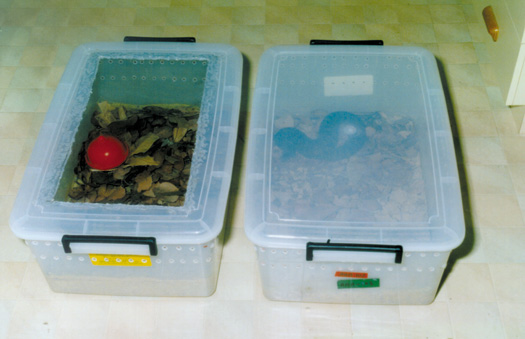
Below: An intermediate sized cage (Click clack), measuring 30 cm in length, which can hold Death Adders up to 60 cm in length without problem (indefinitely). For the purpose of this photo the clear lid is removed from the cage and the water bowl has been removed from it's holder in the cage's substrate (visible in the photo).
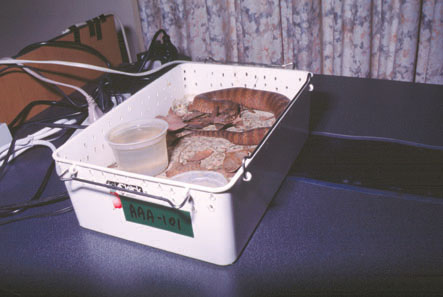
Below: Same caging as in the previous (above) photo. These are the cages these two male snakes were raised in. Shortly after this photo was taken both were moved to the large-sized cage. While Death Adders don't fight one another (as a rule), they still prefer to be on their own and anyone who observes these snakes at close quarters, in terms of their interactions will confirm this.
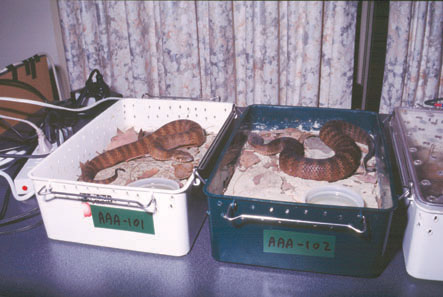
Below: Same caging as in previous above photos. These are the cages these two male snakes were raised in. This time the lids are on the cages. these containers are sold commercially as "Click Clacks" seal well and are available from larger plastic container retailers, or direct from the importers in Adelaide. To drill the ventilation holes in the lids or sides, a soldering iron is best. Holes are best in the upper sides or lid as this is where moisture accumulates. If you get condensation in any part of your cage, you should increase ventilation. If in doubt, more holes are better.
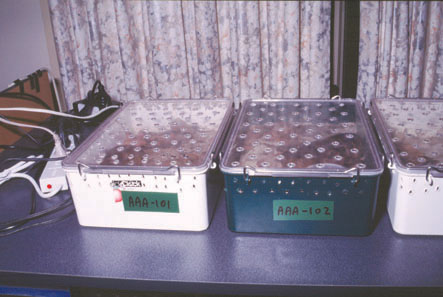
Below (two photos): Shelving for large and small cages and electrical connections for heat mats, dimmers, thermostats and timer switches, all of which can regulate maximum temperatures for the snake's health.
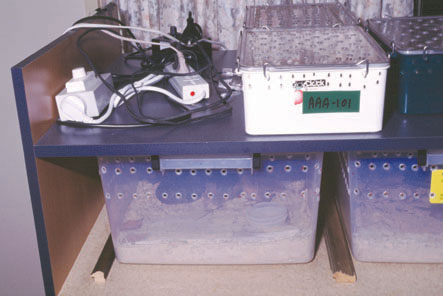
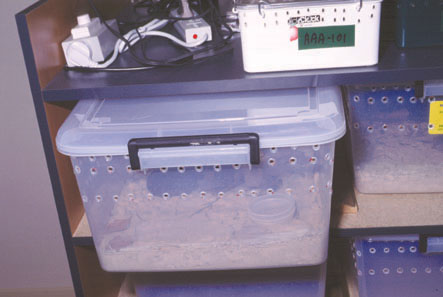
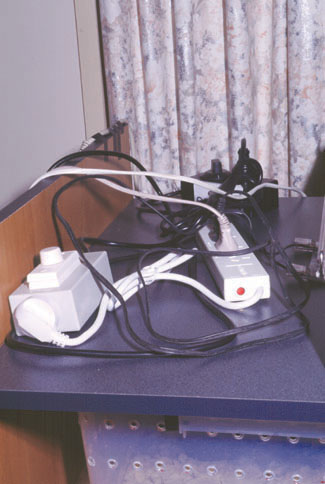
Below (two photos): Cage housing for neonate Death Adders. Everything is the same as for the larger snakes. The only difference is that it is all on a smaller scale. The container here is 15 cm long and is a Chinese Restuarant Take-away tub (We now use a different sort of container of same size with "clip shut" lids, which are available from Chinese Junk Shops as seen in the major cities and sell for about $2 each). The use of white tissue paper is because in these cages the snakes tend to knock this material into the water. Leaves stain the water, whereas tissues merely sink to the bottom and the water remains effectively clean. In the lower picture the replacable water bowl is removed from it's holder (for the purposes of the photo only) which is an identical container set into the hardened substrate. Hence water spillage by the snake is impossible.
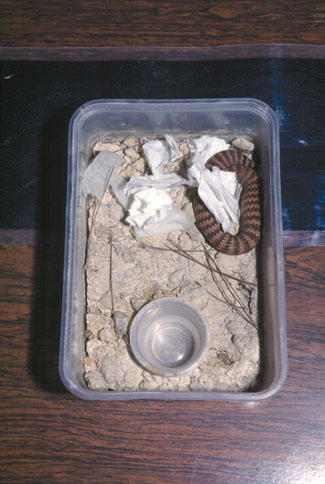
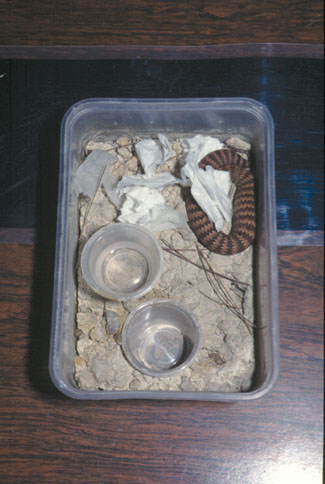
Below: Three sizes of cage used to house Death Adders (The larger cage in this picture has not yet had ventilation holes put in it, or been set-up). No other cage sizes are required. As a rule, one snake per cage only. This housing is also fine for most other species of snake. Note the approximate size classes for each cage (Small cage for neonates to 1 year old as shown, medium cage for 20-60 cm snakes (as shown) and large size for 40 cm upwards to adult (rarely in excess of 90 cm and usually about 60-65 cm). Also note the placement of the cages over the heat mat as shown in the photo below. This is always standard positioning for Death Adder cages. No more heating is neccessary or desireable.
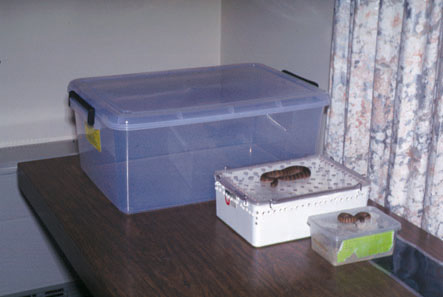
Below: A 60 cm female Death Adder of one year of age inside a larger sized cage sloughing. These snakes normally shed their skins in one piece (as below), or occasionally two or three. Shedding problems in these snakes are rare. Failure to slough properly is therefore a cause for alarm.
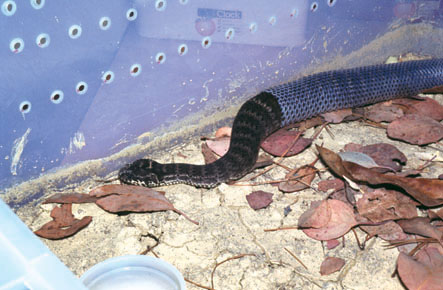
Below: A 60 cm male Death Adder of two years of age immediately after sloughing. Defecation at time of sloughing is normal. Abnormally formed feces is a cause for alarm in captive snakes. The feces shown is a healthy one derived from a rodent diet.
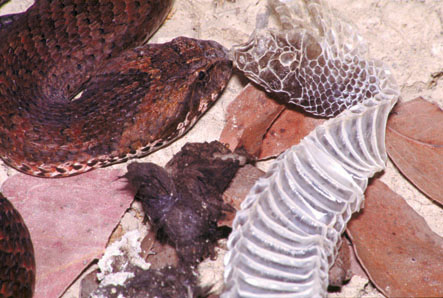
Click here to download and view a 3.3 mb mpg (video) file of two mating Sydney Death Adders.
A major 1995 paper on Death Adders.
Death Adders (Genus
Acanthophis): An overview, including descriptions of five new species and one subspecies An 11,000 word paper
in Monitor - Journal of the Victorian Herpetological Society published
in April 1998.
Death Adders (Genus
Acanthophis): An updated overview, including descriptions of three new species and two subspecies. A 2002 paper published in Crocodilian - Journal of the Victorian Association of Amateur Herpetologists.
Death Adders - Red-grey colour genetics and ramifications in terms of wild populations (1985 paper)
Death Adders - Mating behaviour in captivity (1983 paper)
Death Adders - Breeding in captivity (1987 paper)
Death Adders - Keeping, breeding, etc (2004 article).
Death Adders - Overeating in the wild (1981 paper)
Death Adders - Feeding in captivity (2003 paper)
Death Adders - Colour change in captivity (1985 paper)
Death Adders - Colour change in captivity (1999 paper)
Death Adders - Colour change in captivity (1999 paper)
Virus warning - Death Adders and other Australian snakes (2003) - mortality in neonate Death Adders and other venomous snakes.
Death Adders (and other snakes) - Frequency of sloughing in captivity (1985 paper)
For numerous other papers that deal dominantly or substantially with Death Adders (Acanthophis spp.).